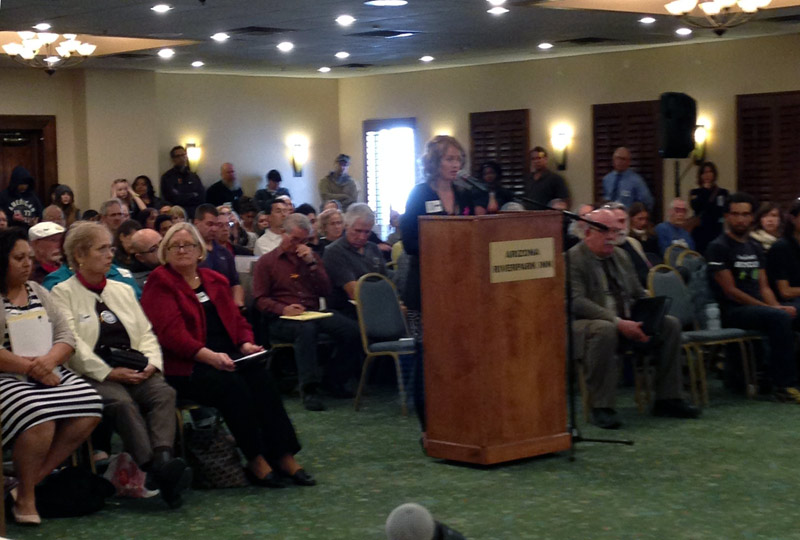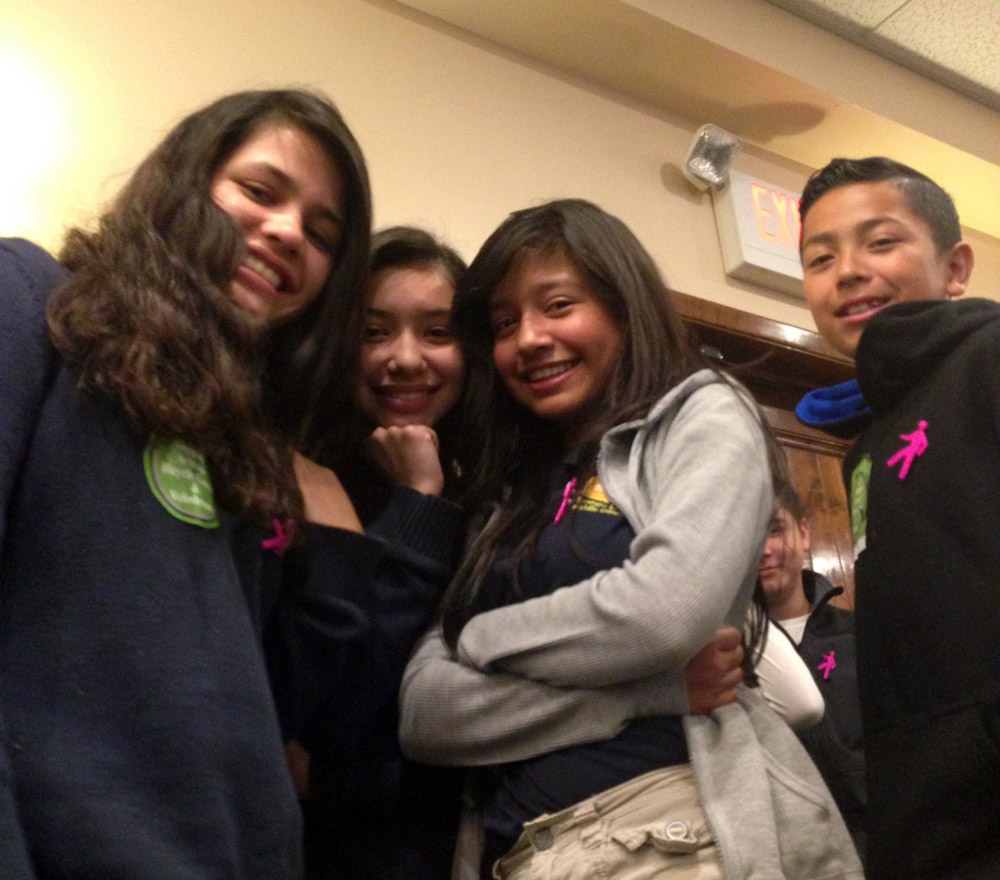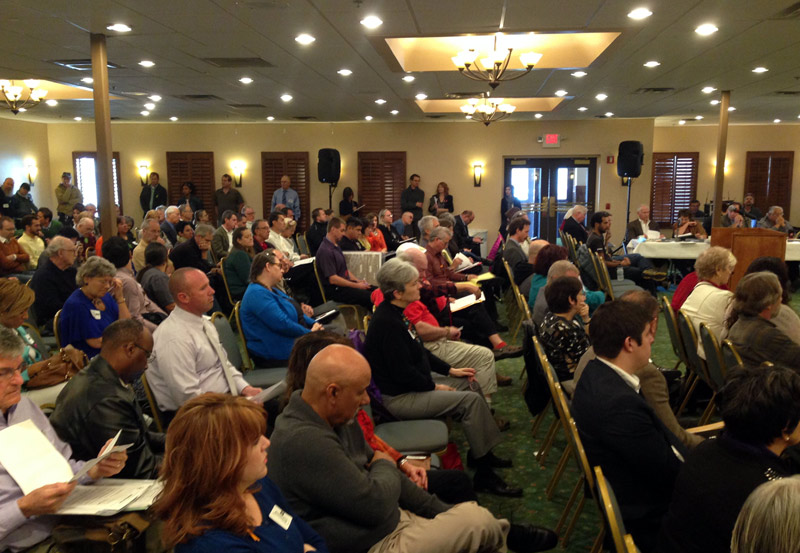 In fighting for change, there's power in getting specific. In biking and walking advocacy, we often highlight infrastructure campaigns that target a major thoroughfare, a particularly dangerous intersection or an underserved community — and celebrate when those efforts result in visible, street-level victories.
In fighting for change, there's power in getting specific. In biking and walking advocacy, we often highlight infrastructure campaigns that target a major thoroughfare, a particularly dangerous intersection or an underserved community — and celebrate when those efforts result in visible, street-level victories.
But, as a growing number of advocacy groups are proving, there's also power in putting significant organizational resources into big-picture efforts that may not pay off today, but reap significant dividends in years to come. Living Streets Alliance in Tucson, Ariz., provided a perfect example last month, when, after two years of work, it got the Pedestrian Safety and Comfort bond measure on the November ballot.
For the past several years — especially through our Advocacy Advance partnership with the League of American Bicyclists — we've been preaching the merits of ballot measures and providing funding through our Rapid Reponse Grants to help advocates win local dollars for active transportation. Just last week, we shared a blog post from Jessica Meaney, who reflected on the success of Bay Area advocates in the passage of Measure BB and highlighted the work of a broad coalition mobilizing for a 2016 ballot proposal.
So, to learn more about the Tucson campaign, I spoke with Emily Yetman, the executive director of the Living Streets Alliance (pictured below). And, I'll be honest: I was surprised by just how transformative a ballot measure campaign can be for a bike-ped organization. Here are some of the highlights of our conversation...
 Carolyn: Tell us a little bit about how did this campaign got started.
Carolyn: Tell us a little bit about how did this campaign got started.
Emily: It came out of a Winning Campaigns Training, actually. At that training, we were talking about pedestrian issues and where do you even begin to address the challenges of pedestrians in our region and we came up with a great campaign with six objectives that addressed all the different aspects of walkability, from changing policy to increasing funding to creating more awareness. We called it the Pedestrian Safety and Comfort Campaign and one of the biggest objectives was to establish and secure more funding for pedestrian improvement projects. Through the process of the Winning Campaigns Training we were able to identify where those sources might be and a county bond came up as a potential source. We were able to identify the right people to talk to and, after the training, had a really key conversation with someone from the county early on who said, "Yeah, why don’t you go after this. It's a great fit." That gave us the green light to move forward.
Carolyn: From a practical perspective, what were some of the steps you took — and lessons learned that might be helpful to other organizations that are interested but maybe a bit intimidated by what can be a pretty complex process?
Emily: Just dive in. You're never going to know how to do this until you try. It's different everywhere. You have to learn through the process — and it's really a great, empowering process for an organization. For us, we first looked at the models that existed [in our region]. For example, there’s another program funded through a bond — the neighborhood reinvestment program — that works with neighborhoods to create improvements, which can be anything from traffic calming to pocket parks. So that model already existed and we looked at how it was worded and talked to everyone we could from that program about how it came about and the mechanisms for managing it. We wanted to understand it inside and out because our initial approach was to replicate that program — to create a transparent process through which projects could be selected and built through this county funding, since the needs change over time. But what we found out is that voters want specificity. We were told this by the bond advisory committee that we had to convince over course of two years that voters want to see projects. They're scared when there's not enough detail — when they don’t know what they're voting for or against. So they suggested we go back and look for projects.
Carolyn: So how did you keep the momentum moving forward, despite setbacks like that?
Emily: For us, it was a moving target. The entire time we were asked to jump through hoops over and over again. We had to be ready and flexible and be willing to do the work — to come back with a refined proposal every single time, to respond to what folks were saying, what doubts the committee had. But, at each of these meetings, when we came back to the bond committee, we had hundreds of people show up and hundreds of people speak. It was incredibly compelling and it changed people’s opinions on this committee. When we started out we had allies but it was a 20+ person committee, and by the end pretty much everyone was in our favor. In the final iteration we had to cut back on the number of projects — we had sometihng like $1 billion in projects and only $650 million in bonding capacity — so we had to cut across the board and drop off the categorical funding. And, even now, after all that has moved forward, we're stil doing some of the negotiations and fine tuning that project list. So it's not over until it's over. It's a huge amount of work, but an incredible opportunity to work with different people.
 Carolyn: We sometimes hear that pedestrian advocacy can be more difficult because people who walk don't necessarily identify as pedestrians, whereas bicyclists tend to identify as such. Was that a challenge?
Carolyn: We sometimes hear that pedestrian advocacy can be more difficult because people who walk don't necessarily identify as pedestrians, whereas bicyclists tend to identify as such. Was that a challenge?
Emily: Actually, I would say we had a huge advantage in representing people on foot, because everyone is a pedestrian. Everyone walks at some point in their day, whether kids walking to school or grandparents walking to the corner store or people getting off the bus. Whereas I think with bicycling it's easy to marginalize riders as a special interest group, when you focus on pedestrian issues it brings people from public health, hospitals, seniors organizations, parents and schools. It's brings people to the table and that was a huge strength.
A local junior high civics teacher wanted to teach his students about the public process, so they learned about our campaign and then attended and observed the Bond Advisory Committee meetings. [The photo shows a few of them at the meeting wearing our neon pedestrian pins that we handed out to our supporters at the door.] A few of them even got up and spoke to the committee, which definitely a powerful moment, since these committees tend to be old white men who only hear from old white men. I think it was eye opening for them to hear directly from youth and to have to consider that these youth were the ones who would be affected by their decisions, since so much of what is funded won't be built until 10 or 12 years from now. And, if nothing else, it certainly grabbed their attention!
Carolyn: So building relationships sounds like a significant benefit of the ballot measure campaign in and of itself.
Emily: It gave us impetus to finally reach out to a number of groups and organizations that we'd been wanting to reach out to for awhile and really have conversations with them, not only in building allies and support but also reaching audiences that don't normally listen to our message. For instance, each of the people on that bond advisory committee they come from really big interest groups. For the most part, many of them are with major developers or the Visitors' Bureau or Chamber [of Commerce] — people who are well known in the community and have influence in the community. They had to hear this and follow it from beginning to end. Through that process they learned a lot about the issue and eventually became advocates in and of themselves. So the captive audience was great: helping people who wouldn’t take the time to think about pedestrians or bikes see it in a different way.
 Carolyn: From a capacity standpoint, what did this look like for you and your staff?
Carolyn: From a capacity standpoint, what did this look like for you and your staff?
Emily: It’s no small undertaking. I think what’s hard is there’s not a schedule for it. You can’t expect that it will take up three hours this week and three hours next week. It's pretty sporadic and when thing move, they move quickly and you have to be in a position to respond, to drop everything and focus on it. Sometimes that eats up a lot of time — to meet with people on the committee, to communication with the committee — so you have to have capacity as an organization to be up for that. We're lucky in that we had some dedicated members and a working group was formed that put in a lot of time as well. I put in probably a good 30% of my time last year and another staff person was probably another 25%. A lot of volunteer time was going toward this, too, but it was a great way to engage people and empowering for volunteers and supporter to get up and speak [at these hearings] and share their story.
Carolyn: So what's next as you move into the get-out-the-vote phase of the campaign?
Emily: Now we’re working very closely with a huge number of organizations and groups that have projects in the bond package to get the word out to vote. It's going to be a huge, huge effort — and we’re just one small piece in this huge machine. We realized that this process sparked something powerful in our community. We’ve been able to experience all these organizations coming together around pedestrian safety and our big question has been: What do we want next? How can we position ourselves to be at the beginning of conversations when discussions of funding come up? Our plan is to convene a summit probably in October to bring all the organizations together and do something along the lines of a Winning Campaigns Training and talk about our shared values and where we'd like to see our region go in terms of walkability.
Carolyn: Biggest lesson learned?
Emily: I really encourage advocacy organizations to jump in. It sounds funny to say it, but I would go through this process now knowing that we were going to lose because it's been such a beneficial experience for the organization. It's really put a spotlight on the organization and allowed us to reach new demographics and new audiences we were never able to before. It's gotten our name out there and given us credibility as being able to bring it in a big way and being able to work with others well; being team players. So, in all honestly, if this passes in November it will be great, but even if doesn’t, the benefits to the organization were worth it in and of itself.
Read more about the Pedestrian Safety and Comfort Bond Measure here!

